Certainly! Here's a brief introduction to the advantages and challenges of TPV (Thermoplastic Vulcanizate) material injection molding:
**Advantages of TPV Injection Molding:**
1. **Flexibility and Elasticity:** TPV materials offer excellent flexibility and elasticity, making them suitable for applications requiring resilience and durability.
2. **Weather Resistance:** TPV materials exhibit high resistance to weathering, UV exposure, and temperature variations, making them ideal for outdoor applications.
3. **Chemical Resistance:** TPV materials are resistant to a wide range of chemicals, oils, and solvents, enhancing their suitability for diverse industrial applications.
4. **Cost-Effectiveness:** TPV injection molding can be a cost-effective solution due to the material's durability, long-term performance, and potential for recyclability.
5. **Noise and Vibration Damping:** TPV materials possess inherent noise and vibration damping properties, making them suitable for use in automotive, machinery, and consumer product applications.
**Challenges of TPV Injection Molding:**
1. **Processing Challenges:** TPV materials can be challenging to process due to their complex formulation, requiring careful optimization of injection molding parameters to achieve desired properties and part quality.
2. **Adhesion Issues:** Achieving proper adhesion between TPV and other materials or components can be challenging, requiring surface treatments or adhesive technologies to ensure strong bonds.
3. **Mold Design Complexity:** TPV materials may require specific mold designs and gating configurations to prevent material degradation, reduce cycle times, and ensure uniform part filling.
4. **Material Handling and Storage:** TPV materials may require special handling and storage conditions to prevent moisture absorption, material degradation, or contamination, which can affect part quality and processing performance.
5. **Shrinkage and Warpage:** TPV materials may exhibit higher shrinkage rates compared to other thermoplastics, leading to challenges in controlling part dimensions and minimizing warpage during cooling and ejection phases of the injection molding process.
In summary, TPV injection molding offers numerous advantages such as flexibility, weather resistance, and chemical resistance, but it also presents challenges related to processing, adhesion, mold design, material handling, and shrinkage control. Addressing these challenges requires careful consideration of material properties, processing parameters, and mold design strategies to ensure successful production of high-quality TPV injection molded products. Regarding this type of injection mold, our company has rich experience in making PEEK Mould, PSU Mould, PPSU Mould.




